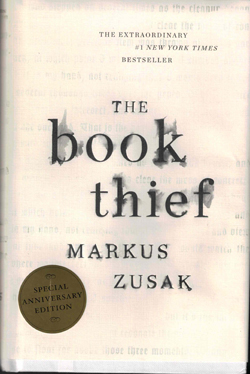The Book Thief (10th Anniversary Edition) by Markus Zusak; Alfred A. Knopf; ISBN 878-0-399-55652-4; 550 pages plus bonus material covering the creative process; $19.99.
By Donald H. Harrison

 SAN DIEGO – Sometimes a book comes out and, like a news article, dies after a period of time, forgotten by everyone except the author and perhaps future researchers with access to Google. Less often, a book survives the test of time, and is deemed worthy of being read by generation after generation. This, it would seem, is the privileged fate of The Book Thief by Australian author Markus Zusak.
SAN DIEGO – Sometimes a book comes out and, like a news article, dies after a period of time, forgotten by everyone except the author and perhaps future researchers with access to Google. Less often, a book survives the test of time, and is deemed worthy of being read by generation after generation. This, it would seem, is the privileged fate of The Book Thief by Australian author Markus Zusak.
The recently-issued tenth anniversary edition of the novel includes in its appendices an interview with Zusak, and even some of his work sheets from the three-year period he took to write the novel. These are interesting, to be sure, but The Book Thief’s real value is to expose some wonderful story telling to people who did not catch the work the first time around, perhaps because they were too young, or for whatever reason, they were otherwise engaged.
The story is set in World War II Nazi Germany and the narrator is the Angel of Death. Rather than being a fearsome scythe-carrying caricature, this Angel is a compassionate being, who sorrows for the many innocent souls he must carry away during times of war and privation.
Busy as the Angel of Death is, he is an inveterate observer of the human condition, pausing here and there to check in on survivors whose loved ones he has taken away. One of these is the young protagonist of the story, Liesel, whom the Angel first met when she was 11, riding with her biological mother and younger brother on a train that would take her to meet foster parents. Her brother, sickly, died en route. At a hasty funeral, Liesel watched as her brother was put into the earth. She wanted something of his memory to remain, and when she saw a book, she stole it, although she was nearly illiterate. It turned out to be a handbook for gravediggers.
Liesel’s foster parents, Hans and Rosa Hubermann, a painter and a homemaker, cuss at each other and Liesel regularly, but behind their mean words are very kind hearts, so kind that they take into their home and hide in their basement a young Jewish man, with whose father Hans had served during World War I. More than that, Max Vandenburg’s father, Erik, also had taught Hans how to play the accordion—the very one that survived after Erik had been blown to pieces while on a patrol from which Erik had contrived to get Hans excused. So, when Max turned up at his door, there was not an iota of a question in Hans’ mind that he must hide Erik’s son as best as they could. Rosa offered no objection; in fact, she seemed gratified by the opportunity to do it. Hans and Rosa warned Liesel of the terrible consequences that could befall all of them if anyone should find out.
There are other fascinating characters whose lives are narrated by the Angel of Death in this layered and nuanced novel. There is Liesel’s next door neighbor, best friend, and had he lived, no doubt her future lover, Rudy Steiner, with whom she played soccer, stole apples, and secreted bread along the route upon which Jews were forced to march to and from the Dachau concentration camp. Not long after the 1936 Olympics, Rudy had put charcoal all over his body and pretended that he was Jesse Owens, the African-American who embarrassed Hitler by beating the Aryan athletes in four races. As one can imagine, neither Rudy nor Liesel were enamored with the Hitler Youth troop that they were required to join.
One day, the Nazis in her town of Molching held a bonfire, into which were thrown books written by Jews and those containing what the Nazis considered to be dangerous ideas. The bonfire did not burn completely and from the ashes, Liesel stole another book.
She loved books, yes, but also she loved reading them aloud with her foster father Hans, who sometimes would sit up all night with her listening to her read, sometimes correcting her pronunciation. When Max came she read with him too. And it turned out that Max brought with him another book, Mein Kampf by Adolf Hitler, which he had carried around in an effort to pass himself off as a loyal German follower of the Fuehrer. Using Hans’ paints, Max painted over the pages of the madman’s book, and when the pages dried, he wrote over them another book, about his life and about the kindness of the Hubermann family.
Ilsa Hermann, the mayor’s wife, long in mourning for her dead son, is another unforgettable character in the novel. Whenever Liesel would pick up washing to be ironed by her mother, she lingered in the library of the big house. Mrs. Hermann saw something of herself in the book-loving girl. Later, after the mayor’s family stopped using the services of Rosa Hubermann, Liesel would regularly return to the house, uninvited, and slip through the window of the library, to steal a book at a time. The mayor’s wife did not complain – she even left Christmas cookies out for her.
What emerges from this novel is a picture of a kind and decent German family—which, had they not been fictional—surely would have been nominated after the war for inclusion among the Righteous of the Nations. Alas, there were not nearly enough such people, and despite their individual efforts, the mass murders continued unabated until Hitler’s suicide and Germany’s surrender.
*
Harrison is editor of San Diego Jewish World. He may be contacted via donald.harrison@sdjewishworld.com. Comments intended for publication in the space below must be accompanied by the letter writer’s first and last name and by his/ her city and state of residence (city and country for those outside the U.S.)